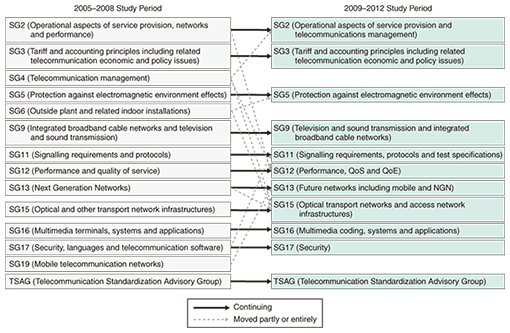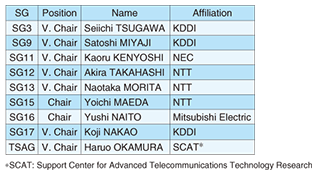 |
|||
|
|
|||
|
Global Standardization Activities Vol. 7, No. 4, pp. 47–50, Apr. 2009. https://doi.org/10.53829/ntr200904gls ITU-T WTSA-08 ResultsAbstractWe present the results of the 2008 World Telecommunication Standardization Assembly (WTSA-08), which was held in Johannesburg, Republic of South Africa, from October 21 to 30, 2008. The meeting was attended by 38 members from Japan and produced important results.
1. Overview of WTSA-08The World Telecommunication Standardization Assembly (WTSA) is an important meeting held once every four years by ITU-T (International Telecommunication Union, Telecommunication Standardization Sector) to revise the organization and working methods for studies and to formulate resolutions on new issues for the coming four years. The important discussion topics were Study Group (SG) restructuring, including the study organization for the Next Generation Network (NGN) and IPTV, an ITU mark, and the new standardization topic of “ICTs and Climate Change” (ICT: information and communications technology). The Japanese delegation contributed to these topics very actively. 2. Working methods2.1 Revised Resolution 1ITU-T activities are specified by Resolution 1, one of the most fundamental Resolutions. At WTSA-08, the Recommendation approval method was changed and its description was changed to accompany the introduction of a patent policy common to ITU, ISO (International Organization for Standardization), and IEC (International Electrotechnical Commission). 2.2 Revised Recommendation A.7The NGN and standardization of IPTV, two important topics in ITU, had been under study by Focus Groups (FGs) and work is currently underway in SGs to develop Recommendations on those topics. An FG includes participants other than ITU-T members. The group itself does not have the authority to develop Recommendations, but it functions as an effective means of bringing in expertise from outside ITU, particularly for dealing with new fields of standardization, analyzing study topics, and identifying items for standardization. WTSA-08 aimed to clarify the procedure for establishing so-called transverse FGs, whose scope encompasses multiple SGs. This is one of the main topics to which Japan has contributed for a long time. 3. SG restructuring issuesThe SG restructuring is shown in Fig. 1.
3.1 NGN standardizationNGN standardization work previously proceeded under a working organization called the Global Standards Initiative (GSI) set up between SG13 and SG11. Since WTSA-04, held in 2004, there has been a firmly rooted opinion that these two SGs should be merged together with SG19 from the viewpoint of the fusion of fixed and mobile communication. In contrast, Japan has consistently spoken out about the importance of work related to protocols in ITU-T and has proposed that SG11 continue as a stand-alone SG. That proposal did not receive much understanding at first, but it gained strength in the meeting of the Telecommunication Standardization Advisory Group (TSAG) prior to WTSA-08. Japan gradually obtained the support of various countries and finally succeeded in forming a consensus to continue SG11. Moreover, from the viewpoint of improving interconnectivity and interoperability, approval was obtained to expand the scope of SG11 activities to include the development of test specifications to verify conformance with ITU-T Recommendations and improve interconnectivity. Toward a common network configuration for the fusion of fixed and mobile communication networks, on the other hand, it was also agreed to merge SG13 and SG19 into a new SG13 for studying future networks and the NGN, including studies from the mobile communication viewpoint. It was also decided that, in a manner similar to that in the previous study period, SG11 and SG13 would be co-located in the new study period from 2009, thus continuing NGN standardization in an integrated manner. 3.2 IPTV standardizationThe standardization of IPTV, which began during the previous study period (2005–2008), has proceeded under the GSI, with preliminary studies by an FG (2006–2007) assembling relevant Questions from multiple SGs (SG9, SG11, SG12, SG13, SG16, and SG17) that convened at the same time. Toward WTSA-08, there had been a controversial discussion on the restructuring of SG9 and SG16, which are the key SGs for IPTV, including the possible merger of those two SGs. Japan proposed to add new Questions with a clear separation of the mandates of those SGs, and vigorously advocated not merging the two SGs. Ultimately, it was agreed that the two SG would continue as independent SGs, under the condition that they have co-located meetings and work in close cooperation with other SGs. 3.3 Other SG restructuringOther points regarding the SG restructuring are listed below.
4. Appointment of SG Chairmen and Vice ChairmenWTSA-08 was the first occasion that Resolution 35 was applied to the appointment of SG Chairmen and Vice Chairmen. That Resolution, which was developed at WTSA-2000, stipulates that a person cannot hold the same post in the same SG for more than two study periods (one study period is four years). Chairs and Vice Chairs are approved on the basis of this Resolution, and of the 11 SG Chairs, including TSAG, eight were newly appointed. From Japan, two SG Chair candidates and seven SG and TSAG Vice Chair candidates were nominated, and all of the candidates were appointed (Table 1). Although the number of SGs (excluding TSAG) was reduced from 13 to 10 at this WTSA, Japan was able to secure the same major level of influence as in the last study period. On the other hand, China gained its first SG Chair at this WTSA, and Korea also increased its number of SG Chairs from one to two, strengthening the influence of those two countries.
5. ICTs and climate change“ICTs and Climate Change” is the newest standardization topic in ITU-T, with study starting at the beginning of 2008. As ICT becomes more widespread around the world, the greenhouse effect gases and carbon dioxide emitted by the ICT sector are increasing, harming the environment through the negative effects of accelerated climate changes. On the other hand, the use of ICT reduces the movement of people and goods, which contributes to reductions in greenhouse effect gas emission in sectors other than ICT. The purpose of this standardization is to establish methods of quantitatively evaluating these positive and negative effects of ICT for climate change and clarify how ICT can contribute to the issue of climate change. First, the specific plan up to March 2009 is to conduct FG activities and then produce Recommendations. WTSA-08 adopted Resolution 73, which describes the objectives of “ICTs and Climate Change” standardization and what items are to be standardized. Japan played a major role in producing that Resolution. It was confirmed that the working organization for the “ICTs and Climate Change” standardization after completion of the FG activities will be decided at the TSAG meeting scheduled for April 2009. 6. ITU markAn ITU mark was proposed by ITU-T in July 2008 as a new system for confirming conformity to ITU-T Recommendations and interconnectivity of communication devices and systems. The developing countries have taken the clear standpoint of accelerating study of this proposal for early implementation of the system, while the standpoint of Europe and the USA is that the study should proceed with prudence because of the increase in work and expense and delay of standardization. Japan, on the other hand, has played the role of gaining a better understanding of various countries on practical matters to be considered in the course of studying the ITU mark by submitting a contribution referring to the activities of HATS (Harmonization of Advanced Telecommunication Systems), which has promoted the interconnectivity of telecommunication devices within Japan, and it has been discussing problems concerning the introduction of this system. Ultimately, Resolution 76 was developed in the form of a collection of opinions of various countries and included a possible report by ITU regarding the results of internal studies toward a concrete system (scheduled to be reported at the next ITU Council in October 2009) in addition to the background and issues for the introduction of the ITU mark. Moving forward from here, there is a plan for cooperation with SG11 to develop test specifications for verifying conformance with ITU-T Recommendations and the abovementioned interconnectivity. 7. Bridging the standardization gapThe standardization gap is an expression that represents the delay in common compliance with standardization in developing countries because of the difficulty of participating in standardization activities and the inability to effectively use standards even when they exist. Bridging the standardization gap is one of the most important issues for ITU as a whole, not just for ITU-T. Developing countries have desired more substantial activities from ITU-T. At WTSA-08, three new resolutions concerning “Bridging the standardization gap” were adopted: Resolution 59 “Enhancing participation of telecommunication operators from developing countries”, Resolution 63 “Studies Regarding Nomadic Communication Services and Applications”, and Resolution 74 “Admission of Sector Members from developing countries in the standardization work of ITU-T”. 8. Future challengesIn this article, we introduced the results of the WTSA-08 meeting. While it has long been said that the influence of ITU-T is diminishing, ITU-T still has tremendous influence in some fields. It is a place where NTT and Japan can seldom contend equally with European countries and the USA. Focusing in particular on new fields of standardization and in cooperation with China, Korea, and various other Asian nations, we hope to make the most of ITU-T. |
|||











